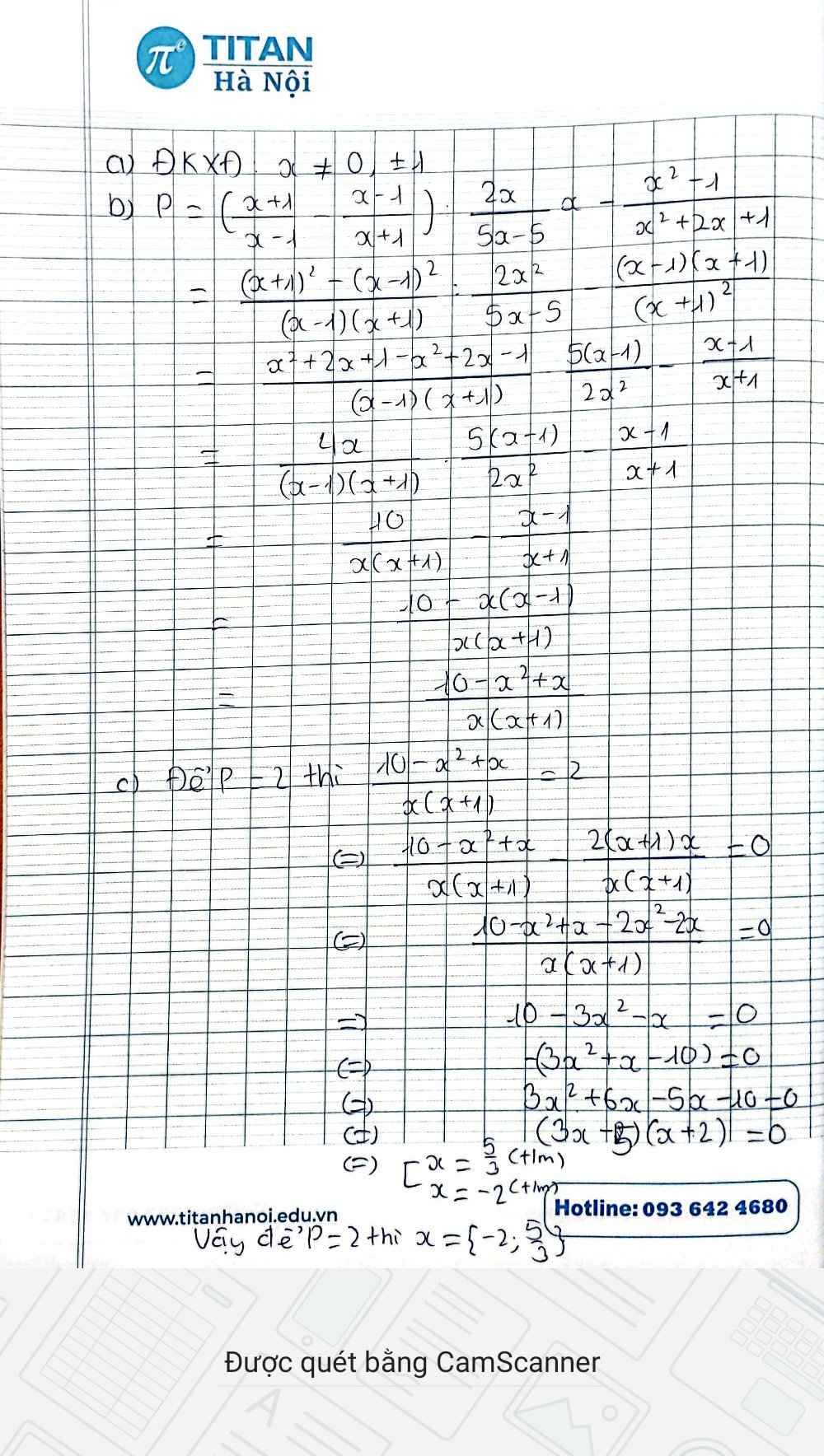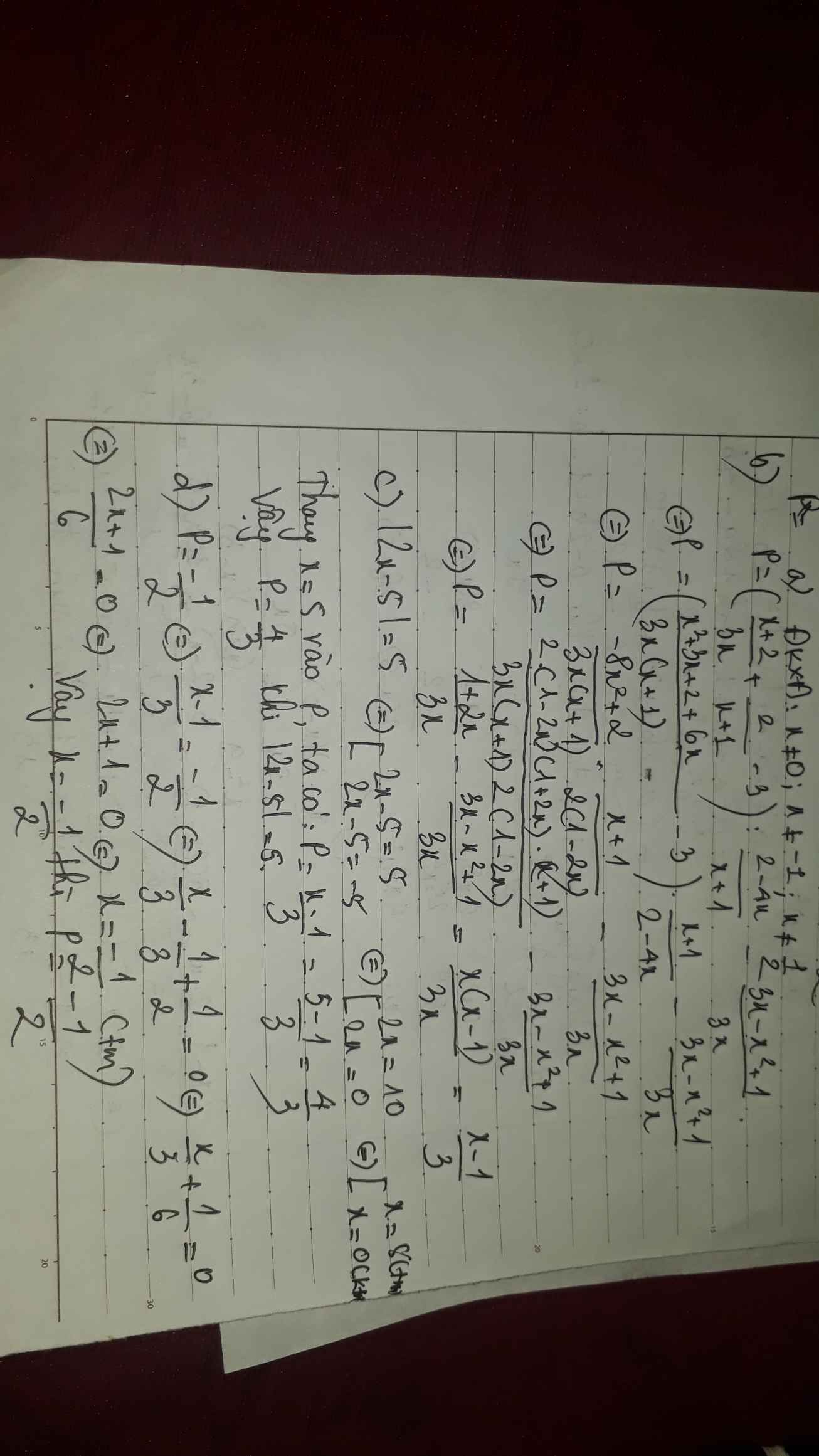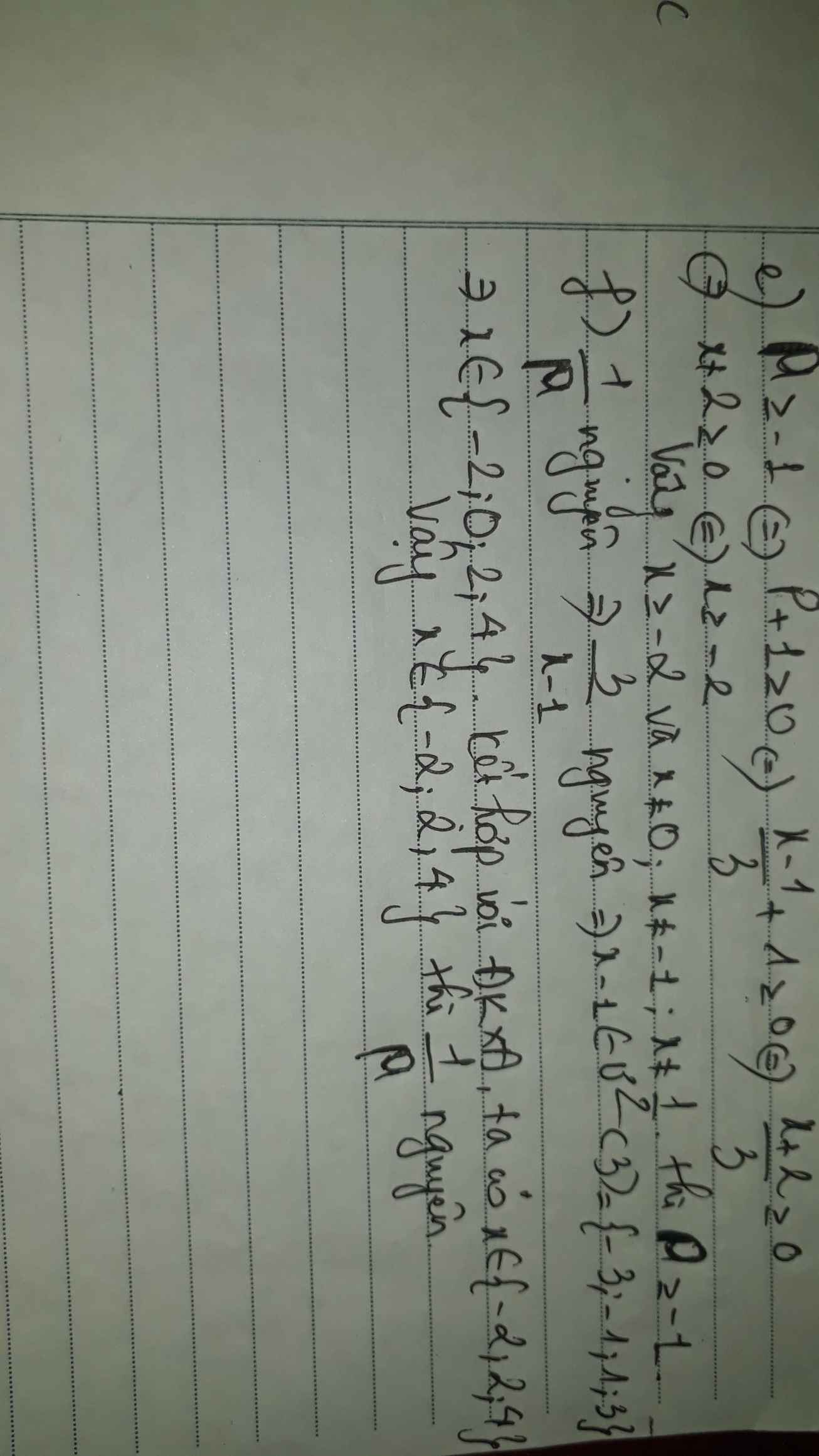Hãy nhập câu hỏi của bạn vào đây, nếu là tài khoản VIP, bạn sẽ được ưu tiên trả lời.

a: ĐKXĐ: \(x\notin\left\{0;1;2;3;4;5\right\}\)
b: \(P=\dfrac{1}{x^2-x}+\dfrac{1}{x^2-3x+2}+\dfrac{1}{x^2-5x+6}+\dfrac{1}{x^2-7x+12}+\dfrac{1}{x^2-9x+20}\)
\(=\dfrac{1}{x\left(x-1\right)}+\dfrac{1}{\left(x-1\right)\left(x-2\right)}+\dfrac{1}{\left(x-2\right)\left(x-3\right)}+\dfrac{1}{\left(x-3\right)\left(x-4\right)}+\dfrac{1}{\left(x-4\right)\left(x-5\right)}\)
\(=\dfrac{-1}{x}+\dfrac{1}{x-1}-\dfrac{1}{x-1}+\dfrac{1}{x-2}-\dfrac{1}{x-2}+\dfrac{1}{x-3}-\dfrac{1}{x-3}+\dfrac{1}{x-4}-\dfrac{1}{x-4}+\dfrac{1}{x-5}\)
\(=\dfrac{1}{x-5}-\dfrac{1}{x}\)
\(=\dfrac{x-\left(x-5\right)}{x\left(x-5\right)}=\dfrac{5}{x\left(x-5\right)}\)
c: \(x^3-x^2+2=0\)
=>\(x^3+x^2-2x^2+2=0\)
=>\(x^2\cdot\left(x+1\right)-2\left(x-1\right)\left(x+1\right)=0\)
=>\(\left(x+1\right)\left(x^2-2x+2\right)=0\)
=>x+1=0
=>x=-1
Khi x=-1 thì \(P=\dfrac{5}{\left(-1\right)\left(-1-5\right)}=\dfrac{5}{\left(-1\right)\cdot\left(-6\right)}=\dfrac{5}{6}\)

a, ĐK : \(x\ne1;2;3;4;5\)
b, \(\dfrac{1}{x\left(x-1\right)}+\dfrac{1}{\left(x-1\right)\left(x-2\right)}+\dfrac{1}{\left(x-2\right)\left(x-3\right)}+\dfrac{1}{\left(x-3\right)\left(x-4\right)}+\dfrac{1}{\left(x-4\right)\left(x-5\right)}\)
\(=\dfrac{1}{x}-\dfrac{1}{x-1}+\dfrac{1}{x-1}-\dfrac{1}{x-2}+\dfrac{1}{x-2}-\dfrac{1}{x-3}+\dfrac{1}{x-3}-\dfrac{1}{x-4}+\dfrac{1}{x-4}-\dfrac{1}{x-5}\)
\(=\dfrac{1}{x}-\dfrac{1}{x-5}=\dfrac{x-5-x}{x\left(x-5\right)}=\dfrac{-5}{x\left(x-5\right)}\)

\(M=\dfrac{1}{\left(x+1\right)\left(x+2\right)}+\dfrac{1}{\left(x+2\right)\left(x+3\right)}+\dfrac{1}{\left(x+3\right)\left(x+4\right)}+\dfrac{1}{\left(x+4\right)\left(x+5\right)}+\dfrac{1}{x+5}\)\(\Rightarrow M=\dfrac{1}{\left(x+1\right)\left(x+2\right)}+\dfrac{1}{\left(x+2\right)\left(x+3\right)}+\dfrac{1}{\left(x+3\right)\left(x+4\right)}+\dfrac{1}{\left(x+4\right)\left(x+5\right)}+\dfrac{x+4}{\left(x+4\right)\left(x+5\right)}\)\(\Rightarrow M=\dfrac{1}{\left(x+1\right)\left(x+2\right)}+\dfrac{1}{\left(x+2\right)\left(x+3\right)}+\dfrac{1}{\left(x+3\right)\left(x+4\right)}+\dfrac{1}{x+4}\)\(\Rightarrow M=\dfrac{1}{\left(x+1\right)\left(x+2\right)}+\dfrac{1}{\left(x+2\right)\left(x+3\right)}+\dfrac{1}{x+3}\)
\(\Rightarrow M=\dfrac{1}{\left(x+1\right)\left(x+2\right)}+\dfrac{1}{x+2}\)
\(\Rightarrow M=\dfrac{1}{x+1}\)
M= \(\dfrac{1}{(x+1)(x+2)}\)+ \(\dfrac{1}{(x+2)(x+3)}\)+ \(\dfrac{1}{(x+3)(x+4)}\)+ \(\dfrac{1}{(x+4)(x+5)}\)+ \(\dfrac{1}{x+5}\)
M= \(\dfrac{1}{x+1}\)- \(\dfrac{1}{x+2}\)+ \(\dfrac{1}{x+2}\)- \(\dfrac{1}{x+3}\)+ \(\dfrac{1}{x+3}\)- \(\dfrac{1}{x+4}\)+ \(\dfrac{1}{x+4}\)+ \(\dfrac{1}{x+5}\)
M= \(\dfrac{1}{x+1} + \dfrac{1}{x+5}\)
M= \(\dfrac{x+5}{(x+1)(x+5)} + \dfrac{x+1}{(x+1)(x+5)} \)
M= \(\dfrac{x+5+x+1}{(x+1)(x+5)}\)
M= \(\dfrac{2x+6}{(x+1)(x+5)}\)
M= \(\dfrac{2(x+3)}{(x+1)(x+5)}\)

Bài 1: ĐKXĐ:`x + 3 ne 0` và `x^2+ x-6 ne 0 ; 2-x ne 0`
`<=> x ne -3 ; (x-2)(x+3) ne 0 ; x ne2`
`<=>x ne -3 ; x ne 2`
b) Với `x ne - 3 ; x ne 2` ta có:
`P= (x+2)/(x+3) - 5/(x^2 +x -6) + 1/(2-x)`
`P = (x+2)/(x+3) - 5/[(x-2)(x+3)] + 1/(2-x)`
`= [(x+2)(x-2)]/[(x-2)(x+3)] - 5/[(x-2)(x+3)] - (x+3)/[(x-2)(x+3)]`
`= (x^2 -4)/[(x-2)(x+3)] - 5/[(x-2)(x+3)] - (x+3)/[(x-2)(x+3)]`
`=(x^2 - 4 - 5 - x-3)/[(x-2)(x+3)]`
`= (x^2 - x-12)/[(x-2)(x+3)]`
`= [(x-4)(x+3)]/[(x-2)(x+3)]`
`= (x-4)/(x-2)`
Vậy `P= (x-4)/(x-2)` với `x ne -3 ; x ne 2`
c) Để `P = -3/4`
`=> (x-4)/(x-2) = -3/4`
`=> 4(x-4) = -3(x-2)`
`<=>4x -16 = -3x + 6`
`<=> 4x + 3x = 6 + 16`
`<=> 7x = 22`
`<=> x= 22/7` (thỏa mãn ĐKXĐ)
Vậy `x = 22/7` thì `P = -3/4`
d) Ta có: `P= (x-4)/(x-2)`
`P= (x-2-2)/(x-2)`
`P= 1 - 2/(x-2)`
Để P nguyên thì `2/(x-2)` nguyên
`=> 2 vdots x-2`
`=> x -2 in Ư(2) ={ 1 ;2 ;-1;-2}`
+) Với `x -2 =1 => x= 3` (thỏa mãn ĐKXĐ)
+) Với `x -2 =2 => x= 4` (thỏa mãn ĐKXĐ)
+) Với `x -2 = -1=> x= 1` (thỏa mãn ĐKXĐ)
+) Với `x -2 = -2 => x= 0`(thỏa mãn ĐKXĐ)
Vậy `x in{ 3 ;4; 1; 0}` thì `P` nguyên
e) Từ `x^2 -9 =0`
`<=> (x-3)(x+3)=0`
`<=> x= 3` hoặc `x= -3`
+) Với `x=3` (thỏa mãn ĐKXĐ) thì:
`P = (3-4)/(3-2)`
`P= -1/1`
`P=-1`
+) Với `x= -3` thì không thỏa mãn ĐKXĐ
Vậy với x= 3 thì `P= -1`

a, ĐKXĐ : \(\left\{{}\begin{matrix}x\ne2\\x\ne3\end{matrix}\right.\)
Ta có : \(P=\dfrac{2x\left(x-3\right)}{\left(x-2\right)\left(x-3\right)}+\dfrac{4}{\left(x-2\right)\left(x-3\right)}-\dfrac{x-2}{\left(x-2\right)\left(x-3\right)}\)
\(=\dfrac{2x\left(x-3\right)+4-x+2}{\left(x-2\right)\left(x-3\right)}=\dfrac{2x^2-6x-x+6}{\left(x-2\right)\left(x-3\right)}\)
\(=\dfrac{2x^2-7x+6}{\left(x-2\right)\left(x-3\right)}=\dfrac{\left(x-2\right)\left(2x-3\right)}{\left(x-2\right)\left(x-3\right)}=\dfrac{2x-3}{x-3}\)
b, Ta có : \(P=\dfrac{2x-3}{x-3}=\dfrac{2x-6+3}{x-3}=2+\dfrac{3}{x-3}\)
- Để P là số nguyên \(\Leftrightarrow x-3\in\left\{1;-1;3;-3\right\}\)
\(\Leftrightarrow x\in\left\{4;3;6;0\right\}\)
Vậy ...
a ĐKXĐ : \(x\ne2,x\ne3\)
\(\Rightarrow P=\dfrac{2x\left(x-3\right)+4-\left(x-2\right)}{\left(x-2\right)\left(x-3\right)}=\dfrac{2x^2-6x+4-x+2}{\left(x-2\right)\left(x-3\right)}=\dfrac{2x^2-7x+6}{\left(x-2\right)\left(x-3\right)}=\dfrac{2x^2-7x+6}{x^2-5x+6}\)b Ta có P = \(\dfrac{2x^2-7x+6}{x^2-5x+6}=\dfrac{x^2-5x+6+x^2-2x}{x^2-5x+6}=1+\dfrac{x\left(x-2\right)}{\left(x-2\right)\left(x-3\right)}=1+\dfrac{x}{x-3}\)
Để P\(\in Z\) \(\Leftrightarrow1+\dfrac{x}{x-3}\in Z\) \(\Rightarrow\dfrac{x}{x-3}\in Z\) \(\Rightarrow x⋮x-3\) \(\Rightarrow x-3+3⋮x-3\)
\(\Rightarrow3⋮x-3\) \(\Rightarrow\left(x-3\right)\in\left\{-3;-1;1;3\right\}\) \(\Rightarrow x\in\left\{0;2;4;6\right\}\)
Thử lại ta thấy đúng
Vậy...

a) \(ĐKXĐ:\hept{\begin{cases}x\ne\pm2\\x\ne-3\end{cases}}\)
b) \(P=1+\frac{x+3}{x^2+5x+6}\div\left(\frac{8x^2}{4x^3-8x^2}-\frac{3x}{3x^2-12}-\frac{1}{x+2}\right)\)
\(\Leftrightarrow P=1+\frac{x+3}{\left(x+3\right)\left(x+2\right)}:\left(\frac{8x^2}{4x^2\left(x-2\right)}-\frac{3x}{3\left(x^2-4\right)}-\frac{1}{x+2}\right)\)
\(\Leftrightarrow P=1+\frac{1}{x+2}:\left(\frac{2}{x-2}-\frac{x}{\left(x-2\right)\left(x+2\right)}-\frac{1}{x+2}\right)\)
\(\Leftrightarrow P=1+\frac{1}{x+2}:\frac{2x+4-x-x+2}{\left(x-2\right)\left(x+2\right)}\)
\(\Leftrightarrow P=1+\frac{1}{x+2}:\frac{6}{\left(x-2\right)\left(x+2\right)}\)
\(\Leftrightarrow P=1+\frac{\left(x-2\right)\left(x+2\right)}{6\left(x+2\right)}\)
\(\Leftrightarrow P=1+\frac{x-2}{6}\)
\(\Leftrightarrow P=\frac{x+4}{6}\)
c) Để P = 0
\(\Leftrightarrow\frac{x+4}{6}=0\)
\(\Leftrightarrow x+4=0\)
\(\Leftrightarrow x=-4\)
Để P = 1
\(\Leftrightarrow\frac{x+4}{6}=1\)
\(\Leftrightarrow x+4=6\)
\(\Leftrightarrow x=2\)
d) Để P > 0
\(\Leftrightarrow\frac{x+4}{6}>0\)
\(\Leftrightarrow x+4>0\)(Vì 6>0)
\(\Leftrightarrow x>-4\)

\(a,ĐK:x\ne\pm1\\ b,B=\dfrac{x^2+x-x^2-1}{2\left(x-1\right)\left(x+1\right)}=\dfrac{x-1}{2\left(x-1\right)\left(x+1\right)}=\dfrac{1}{2\left(x+1\right)}\\ c,B=-\dfrac{1}{2}\Leftrightarrow2\left(x+1\right)=-2\Leftrightarrow x+1=-1\Leftrightarrow x=-2\left(tm\right)\)



a: ĐKXĐ: \(x\notin\left\{0;1;2;3;4;5\right\}\)
b: \(P=\dfrac{1}{\left(x-1\right)\cdot x}+\dfrac{1}{\left(x-2\right)\left(x-1\right)}+\dfrac{1}{\left(x-2\right)\left(x-3\right)}+\dfrac{1}{\left(x-3\right)\left(x-4\right)}+\dfrac{1}{\left(x-4\right)\left(x-5\right)}\)
\(=\dfrac{1}{x-1}-\dfrac{1}{x}+\dfrac{1}{x-2}-\dfrac{1}{x-1}+\dfrac{1}{x-3}-\dfrac{1}{x-2}+\dfrac{1}{x-4}-\dfrac{1}{x-3}+\dfrac{1}{x-5}-\dfrac{1}{x-4}\)
\(=\dfrac{1}{x-5}-\dfrac{1}{x}=\dfrac{x-x+5}{x\left(x-5\right)}=\dfrac{5}{x\left(x-5\right)}\)